Comparison of Different Types of Anesthesia
- ByMedical Content Team
- Medically Reviewed byDr. Sabine Kulhanek
Fact checked
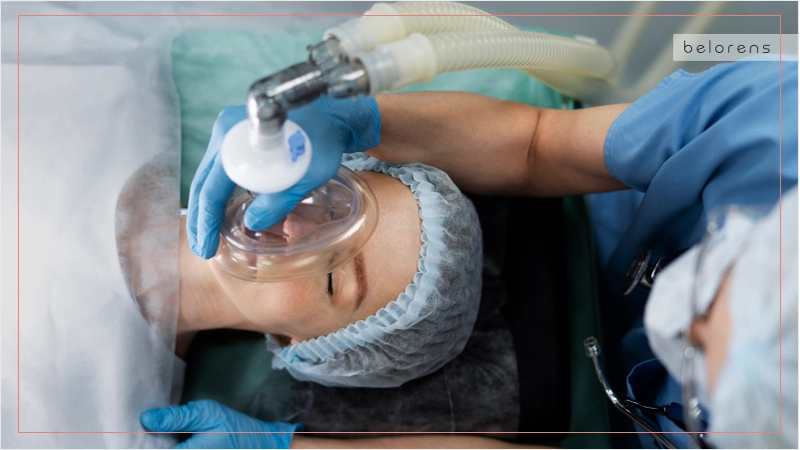
Table of contents
Imagine the world without anesthesia: only people who can tolerate pain would consider having cosmetic surgery. But thanks to the development of anesthetic drugs, all people can now think about having cosmetic surgery without fear of pain.
Anesthetic medicines are generally administered to ensure the patient is comfortable and oblivious to the pain during the surgical process. Anesthesia comes in different types and is administered through several means. How you'll receive anesthesia depends on factors like your health condition, type of anesthesia, preferences, e.t.c.
Let's look into different types of anesthesia and answer some frequently asked questions of most people looking to get cosmetic surgery.
Types of Anesthesia
Anesthesia can be classified as general, regional, local, topical, and sedation. Occasionally, a patient may be given a mixture of anesthetics. Factors like the surgery type, patient's age, health status, and the type of anesthetic to be utilized affect the decision about whether or not the patient needs a mixture or a single type of anesthesia.
comparing the different types of anesthesia:
| Type of Anesthesia | Description | Suitable for | Advantages | Potential Side Effects |
|---|---|---|---|---|
| General Anesthesia | Provides complete unconsciousness and pain relief. | Invasive surgeries | Deep sedation, muscle relaxation | Nausea, vomiting, sore throat, shivering, confusion |
| Regional Anesthesia | Numbs specific areas of the body. | Procedures involving a larger area | Reduced bleeding, postoperative pain relief | Nerve damage, headache, infection |
| Local Anesthesia | Numbs only the surgical site, keeping the patient conscious. | Minor procedures | Minimal systemic effects | Allergic reactions, local tissue damage |
| Topical Anesthesia | Anesthetic solutions applied directly to the target area. | Minor procedures on the skin or mucous membranes | Non-invasive, minimal discomfort | Allergic reactions, skin irritation |
| Sedation | Induces a relaxed, drowsy state but not complete unconsciousness. | Minor procedures, endoscopy | Less risk than general anesthesia, quicker recovery | Respiratory depression, dizziness, headache |
Please note that this table provides a general overview, and the suitability and potential side effects of each type of anesthesia can vary depending on individual factors and the specific procedure. It's important to consult with a healthcare professional to determine the most appropriate anesthesia for your situation.
General Anesthesia
When patients are given general anesthesia, they go into a sleep-like status, are utterly unaware of what is happening around them, and don’t feel any pain.
This anesthetic is usually administered intravenously (IV: through a vein) or inhaled (NOM: nose and mouth). After patients fall unconscious under general anesthesia, a tube will be inserted into their throats to assist them in breathing.
General anesthesia is highly recommended for cosmetic procedures that are more invasive and take a long time, like tummy tuck, rhinoplasty, breast surgery, etc. Most anesthesiologists believe that general anesthetic is more reliable for long-term procedures because it gives the doctor perfect control and allows extra medications to be administered when needed since there is already an IV line.
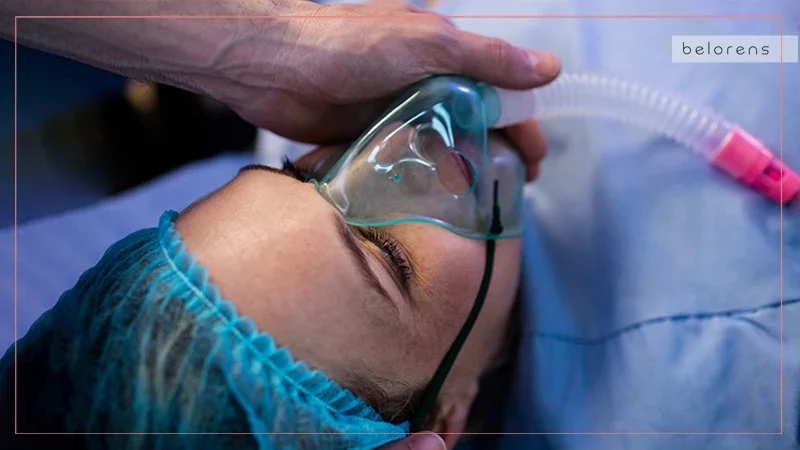
What procedures require general anesthesia?
A general anesthetic is usually used for cosmetic surgeries like rhinoplasty, facelift, liposuction, plastic surgery in young children, etc. It's also the most preferred choice when it comes to combined surgeries.
Although general anesthesia can last long, it is usually clocked according to the duration of the surgery. It may be readministered to ensure the patient doesn't wake up during the procedure.
After surgery, some patients might experience side effects like allergies, motion sickness, headaches, vomiting, etc. Some people might not experience any of this. Don't be scared; the side effects are temporary and primarily go away within 24 hours.
Here are more examples of cosmetic surgeries that usually require general anesthesia: Scalp reduction surgery, jaw surgery, chin reduction, Adam's Apple reduction, rhinoplasty, liposuction, breast augmentation, butt augmentation, and Brazilian butt lift.
However, in some of these cases, general anesthesia may be replaced by another type.

Regional Anesthesia
When anesthetic is injected near a group of spinal nerves it is called regional anesthesia. This results in losing sensation in a vast body part, making it difficult to feel the pain. For example, epidural and spinal blocks are two common regional anesthetics.
• Epidural type
Epidural anesthesia is administered to the specific region of the spinal area mainly to reduce pain from complex surgery. Procedures in the pelvis and the lower-abdomen area usually require this type of anesthesia such as liposuction.
• Spinal type
Spinal anesthesia, on the other hand, is administered into the spinal canal. This anesthesia has a record of being effective for up to 4 hours.
They are usually administered for a surgical process involving the lower part of the body, like the abdominal area. It can be used for almost all trunk and limb surgeries, such as abdomen (abdominoplasty) surgery.
Sedation
Sedation is another anesthesia technique that is also referred to as monitored anesthesia care or twilight sedation. It is usually delivered through IV in less complicated and shorter procedures. Sedation helps the patient feel relaxed and induces a feeling of drowsiness. Minor cosmetic procedures such as lip augmentation or reduction can be done using sedation.
There are three levels of sedation depending on the procedure: mild, moderate, and deep. However, sedation may also be classified into oral and IV sedation where oral sedation, also known as conscious sedation, is the milder one obtained through oral medication in order to relax the patient and relieve anxiety while IV sedation is the deeper type of sedation in which the sedative is administered intravenously.
• Mild (oral sedation)
Patients given mild or minimal sedation are usually awake during the procedure, can talk, respond to questions, and follow instructions. Mild sedation may be used in some colonoscopies, eye procedures, and cardiac catheterization.
• Moderate
People under moderate sedation usually fall asleep but can be awakened easily. Some colonoscopies and biopsies may need moderate sedation.
• Deep (IV sedation)
Deep sedation is similar to general anesthesia as in both the patient is in a deep sleep and won’t remember the procedure. However, in deep sedation, the patient is not unconscious and usually doesn’t require assisted breathing.
Also Read: Aesthetic Medicine: Specialties That Offer Cosmetic Solutions
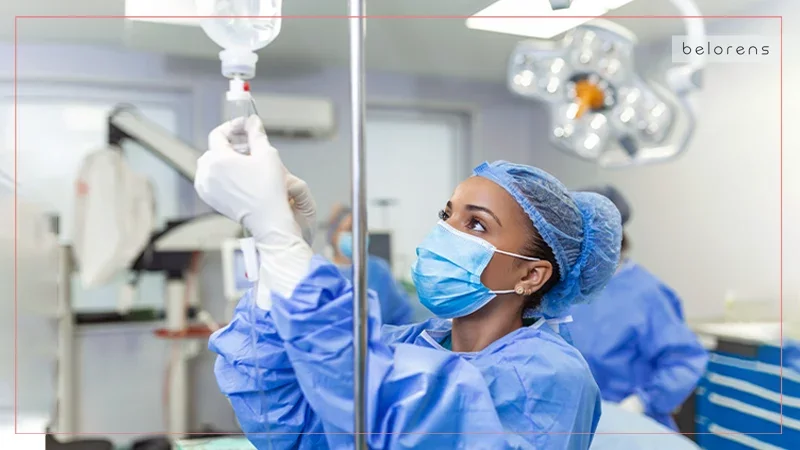
Local Anesthesia
To put it simply, local anesthesia entails solely numbing the area where the surgery will be performed while keeping the patient conscious. This is accomplished before surgery by administering tiny injections to the operation site.
Patients don't need mechanical ventilation because it doesn't paralyze them as a general anesthetic. As a result, the effects wear off more rapidly after the treatment is finished. As soon as the patient has recovered from the anesthetic, they can usually go home independently.
What procedures require local anesthesia?
Many types of plastic surgery can be safely performed under local anesthetic. The patient's health status, history of reactions to the medicines used in either form of anesthesia, and the treatment must be considered to decide whether to utilize local or general anesthesia. Training in this area involves years of experience and careful consideration of each patient's unique circumstances. Some cosmetic procedures usually done under local anesthesia are hair transplant, lip augmentation, dental implants, and lipoma removal surgery.
Topical Anesthesia
Topical anesthesia is used to induce a minor loss of sensation in areas like the conjunctiva, mucous membranes, or skin. This anesthesia usually involves the application of local anesthetic solutions, ointments, gels, or sprays directly on the target area.
By momentarily blocking nerve conduction around the application area, topical anesthetic causes a loss of feeling. When applied to the skin, topical anesthetics block sodium channels in nerve endings and prevent sodium ions from entering nerve cells. The anesthetic numbs the nerve cells in the area, preventing them from sending pain signals to the brain.
Various kinds of topical anesthetic drugs are available, and the method of administration is determined by the area to be numbed. They are in the form of ointments, gels, and creams.
Procedures that use this technique are typically minor skin procedures such as laser resurfacing and microneedling.
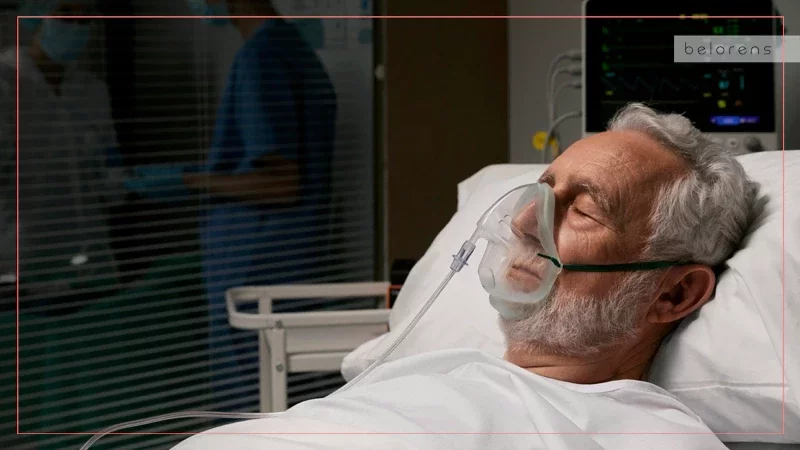
What is the Safest Anesthesia?
The widespread misconception is that an operation requiring general anesthesia is inherently dangerous. However, it is crucial to note that this anesthetic can be safe if all the proper precautions are taken. As a general rule, difficulties stem from pre-existing conditions, such as heart and liver diseases, rather than the anesthetic itself.
In many complex and painful procedures or those involving the airway such as nasal surgeries, general anesthesia can be the safest option since the patient is unconscious with no awareness of the procedure while is totally monitored by the anesthesiologist and the airway is controlled using a tube. However, general anesthesia can have a longer recovery and may have some side effects such as nausea. IV sedation, on the other hand, brings the patient a similar experience except it doesn’t involve a tube in the airway, therefore it doesn’t have the side effects of general anesthesia.
Local anesthesia is the safest type since it only numbs a small area of the body throughout the process and rarely causes any side effects. It is pretty rare for a patient to feel any discomfort or itching due to drug injections. However, as mentioned above, it may not be a suitable choice for all procedures since being aware and witnessing the procedure going on would be an unpleasant experience for you.
It is also safer to use a regional anesthetic to numb a part of the body, rather than the entire body, such as from the waist down. The regional anesthetic can cause headaches in some patients. However, this is not always the case. Lung collapse may occur in rare circumstances of injections administered through the chest. In addition, nerve injury can occur as a result of regional anesthetic.
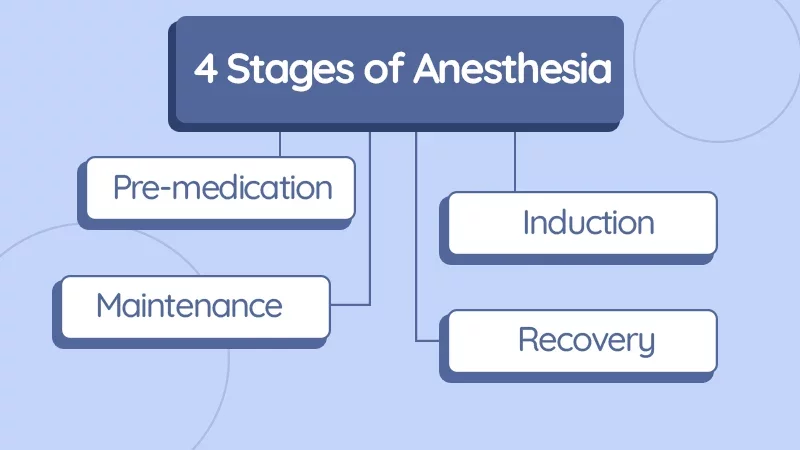
What are the 4 Stages of Anesthesia?
Doctors developed a monitoring system to ensure patient safety before the availability of equipment that tracks vital signs under general anesthesia. There is a four-stage technique to ensure safety during the surgery.
• Pre-medication
The term "premedication" refers to the pre-anesthesia administration of medication to alleviate anxiety, control pain, reduce the danger of aspiration pneumonitis, and reduce the risk of postoperative nausea and vomiting.
• Induction
This is the stage where anesthesia is introduced into the patient's body. The patients may or may not lose consciousness depending on the anesthesia used. In the case of general anesthesia, it completely relaxes the patient’s muscles when it gets to a certain intensity. It's at this point that artificial ventilation is introduced.
These are the stages that follow during induction of anesthesia:
- Analgesia or disorientation. The "induction stage" is a common term to characterize this phase. Patients are anesthetized but able to communicate. Slow and steady breathing is evident. The patient is now transitioning from analgesia without amnesia to analgesia and amnesia simultaneously. Consciousness is lost at the end of this stage.
- Excitement: Uncontrollable movements, lack of eyelid reflex, hypertension, and tachycardia characterize the second stage of excitement or delirium. During this time, the airway reflexes remain intact but are more sensitive to stimuli.
Endotracheal tube insertion and removal, as well as deep suctioning, should be avoided during this stage of anesthesia. Laryngospasm (involuntary tonic closure of the vocal cords) is more likely at this time, and any manipulation of the airway may exacerbate it.
As a result, the patient's airway may be compromised by spastic movements, vomiting, and rapid, erratic breathing. A shorter period in stage 2 is made feasible by using fast-acting medicines, which allows for a quicker transition to the final stage.
- Surgical level: This is the level of anesthesia used for surgical procedures that require general anesthesia. In this stage, the eyes stop moving and the breathing slows down. This level of airway manipulation is safe. This means that it is safe to carry out the surgical process. The surgeon won’t begin the surgery unless this stage is attained.
• Maintenance
The anesthesiologist monitors the effect of the anesthesia and determines if there is a need for reapplication. This ensures the patient doesn't wake up during the procedure.
• Recovery
This is the process of weaning the patient off the anesthesia, mainly in the case of general anesthesia.
Also Read: Fasting Before Surgery: What Are The Reasons?
Common Questions About Anesthesia
Q: What is the longest you can be under anesthesia?
A: You can remain under anesthesia for several hours but when anesthesia lasts longer than six hours, there will be an increased risk of complications.
Q: Does anesthesia shorten your life?
A: No, there is no compelling evidence that anesthesia can shorten life.
Q: Do you pee under general anesthesia?
A: The bladder muscles are paralyzed by general anesthesia. This can make it difficult to pee and affect your capacity to notice that you need to urinate. In addition, a Foley catheter—a tube inserted into the body to empty urine from the bladder—is used in many procedures.
Q: Does your heart stop under general anesthesia?
A: Many of your body's natural autonomic activities are suppressed by general anesthesia. Among these are the ones in charge of respiration, heartbeat, blood circulation (such as blood pressure), and digestive system movements. Your heart doesn't stop but its functions are suppressed.
Q: How long does anesthesia stay in your body?
A: After an operation, most patients are awake in the recovery room but still sleepy for a few hours. Although it may take up to a week for your body to entirely rid itself of the medications, many people do not feel much difference after just 24 hours.
Q: What happens if you stop anesthesia during surgery?
A: Anaphylaxis, a life-threatening allergic reaction to the anesthetic, and accidentally waking up during surgery are all serious risks and complications that can occur during your procedure. However, the anesthetic administered will be closely monitored to help prevent these outcomes. Death is relatively uncommon.
Q: Do you dream under anesthesia?
A: There is no lucid dreaming while under anesthesia. It's unwise to confuse general anesthesia with natural sleep.
Q: Why are eyes taped shut in surgery?
A: Tape or ointment can help protect the cornea during general anesthesia. Passive closure, hypoallergenic tape, hypoallergenic eye patches, and saline-soaked pads have all been used to keep the eyelids closed.
Q: Do you talk under general anesthesia?
A: Patients cannot speak during anesthesia, but it is not unusual for them to do so upon waking up.
Q: Can someone not wake up from anesthesia?
A: Although standard anesthetic medicines allow patients to recover in as soon as a few minutes, a condition known as delayed emergence can occur. Delays in operating rooms and an overall increase in expenditures have been linked to this problem.
Q: What medicines do doctors use for anesthesia?
A: The sedative-hypnotic drugs often used to induce general anesthesia include etomidate, propofol, ketamine, and adjuvant agents such as opioids, lidocaine, and midazolam. Adjuvant agents are often used to enhance the effects of the primary sedative-hypnotic induction agent.
Summery
Anesthesia has revolutionized the field of cosmetic surgery, making it accessible to everyone without fear of pain. There are various types of anesthesia, including general, regional, local, topical, and sedation, each suitable for different procedures. General anesthesia is recommended for more invasive surgeries, providing complete unconsciousness and pain relief. Regional anesthesia involves numbing specific areas of the body, while local anesthesia numbs only the surgical site, keeping the patient conscious. Topical anesthesia is used for minor procedures by applying anesthetic solutions directly to the target area.
The safety of anesthesia depends on various factors, and each type has its advantages and potential side effects. General anesthesia may be safer for complex and longer surgeries, while local anesthesia is considered the safest as it numbs a smaller area. Anesthesia is administered in four stages: pre-medication, induction, maintenance, and recovery.
Common questions about anesthesia include its duration, effects on life span, urination, heart function, dreams, and waking up. Complications like anaphylaxis and accidental waking up during surgery are rare but monitored by professionals.
In conclusion, anesthesia has made cosmetic surgery accessible and safe for patients by providing different options based on the procedure and individual health conditions. It is crucial to work with skilled anesthesiologists to ensure a smooth and safe surgical experience.



